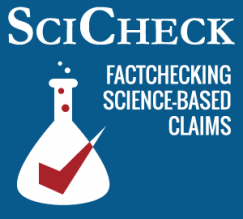Is Bacon Really Better For You Than Tilapia?
Long story short: No.
This article was originally published at FactCheck.org as part of their SciCheck series.

Multiple websites, such as edrugsearch.com, eatthis.com and draxe.com, have claimed that scientists have found hamburgers and bacon are better for you than tilapia. Versions of these articles have spread through Facebook, with users flagging them as potentially fake. SciCheck readers also have asked about the dangers of eating tilapia.
 Many of these alarming articles about tilapia claim that bacon is a better health option than tilapia because the fish lacks essential nutrients and can increase risk of cancer and Alzheimer’s disease. But there is no solid evidence that eating tilapia increases the risk of either of these diseases.
Many of these alarming articles about tilapia claim that bacon is a better health option than tilapia because the fish lacks essential nutrients and can increase risk of cancer and Alzheimer’s disease. But there is no solid evidence that eating tilapia increases the risk of either of these diseases.
The fish is also a low-fat source of protein and a number of vitamins and minerals, including vitamin B12 and selenium. However, other fish, such as salmon, are a better source of omega-3 fatty acids, which are essential nutrients.
Experts told SciCheck there’s no debating whether or not bacon and hamburgers are better for you than tilapia — they’re not. Both bacon and hamburgers are high-fat sources of protein. Bacon is also high in added sodium.
Where did this idea that bacon is better for you than tilapia come from in the first place?
Some of the anti-tilapia articles point to a controversial scientific study published in the Journal of the American Dietetic Association in July 2008.
In that paper, Floyd H. Chilton, a professor of physiology and pharmacology at Wake Forest University, and his colleagues conclude that “tilapia is not a good choice” for “individuals who are eating fish as a method to control inflammatory diseases such as heart disease.” The researchers add: “All other nutritional content aside, the inflammatory potential of hamburger and pork bacon is lower than the average serving of farmed tilapia.”
Inflammation is the body’s response to toxins or unwanted substances; it can occur in the arteries when cholesterol forms plaque.

Shortly after the study was published, a number of experts wrote an open letter disputing the idea that tilapia was unhealthy. “Tilapia and catfish are examples of lower-fat fish that have fewer omega-3s” than oily fish, but “still provide more of these heart-healthy nutrients than hamburger, steak, chicken, pork or turkey,” they wrote. “Replacing tilapia or catfish with ‘bacon, hamburgers or doughnuts’ is absolutely not recommended,” they cautioned. In November 2008, Harvard Medical School wrote a letter similarly concluding that tilapia is a “good choice for dinner.”
Still, years later, Chilton’s finding about inflammatory potential, which did not concern “all other nutritional content,” continues to be twisted into claims that bacon is generally healthier than tilapia.
SciCheck reached out to Chilton for comment, but he didn’t respond. However, he told Fox News in April 2014 that his research was being taken out of context by those warning against tilapia’s risks.
“We never intended to paint tilapia as the cause of anything bad,” he said. But, he added, “If your doctor or cardiologist is telling you to eat more fish, then you should look for varieties that have higher levels of omega-3 and avoid those with high inflammatory potential.”
How did Chilton and his colleagues come to their conclusion that tilapia has a high inflammatory potential, higher than bacon and hamburgers?
[This is the state of U.S. pork.]
Chilton and his team measured the content of omega-3 and omega-6 fatty acids in 30 “commonly consumed farmed and wild fish,” including tilapia, salmon, tuna, cod, catfish and trout. The researchers found that farmed trout and Atlantic salmon contained “relatively high concentrations” of omega-3 fatty acids, while farmed tilapia and catfish contained “much lower concentrations” of these essential nutrients.
They also found that farmed trout and Atlantic salmon had low ratios of omega-6 to omega-3 fatty acids, whereas farmed catfish and tilapia had high ratios of these compounds, meaning they had notably more omega-6 than omega-3 fatty acids.
Omega-3 and omega-6 fatty acids are two groups of chemical compounds that are essential to the normal functioning of the body, but that humans can only obtain through food. Among other things, the body uses these nutrients to form molecules that regulate the functioning of the heart, lungs and and immune system. These compounds are also found to regulate processes in the brain.
The science is clear that eating fish high in omega-3 fatty acids is associated with a lower risk of heart disease and failure, says the National Institutes of Health.
As for omega-6 fatty acids, the American Heart Association concluded that research indicates consumption of 5 percent to 10 percent of an individual’s energy from omega-6 fatty acids “reduces the risk” of coronary heart disease “relative to lower intakes.” The association added, “The data also suggest that higher intakes appear to be safe and may be even more beneficial.”
Some researchers argue that it’s the ratio of omega-6 to omega-3 fatty acids that matters most for preventing heart disease, not the absolute quantities of each, says the NIH. But no study has pinpointed an optimal ratio. The NIH adds that still other researchers argue the ratio theory isn’t a good measure for predicting or preventing disease.
So there’s no scientific consensus on the ratio theory. But Chilton and his team used tilapia’s high omega-6 to omega-3 ratio to argue that tilapia had a high inflammatory potential in their 2008 paper.
Chilton and his team also argue that omega-6 fatty acids, specifically one type, arachidonic acid, are generally inflammatory. Since they found that tilapia contained “high quantities of arachidonic acid,” the researchers concluded that tilapia is not a “good choice” for “individuals who are eating fish as a method to control inflammatory diseases such as heart disease.”
What about compared with bacon and hamburgers?

The researchers measured, on average, 134 milligrams of arachidonic acid in 100 grams of tilapia, with some samples reaching 300 mg per 100 g. They also say that 100 grams of bacon and hamburgers contain 191 mg and 34 mg, respectively, of arachidonic acid, based on the U.S. Department of Agriculture’s National Nutrient Database Standard Reference Release 20. This led Chilton and his team to conclude: “All other nutritional content aside, the inflammatory potential of hamburger and pork bacon is lower than the average serving of farmed tilapia.”
Other experts dispute the measurements in the Chilton study.
Chilton and his co-authors claim that tilapia “contain[s] some of the highest levels of arachidonic acid found in human beings’ food chain,” but William S. Harris, an expert in fatty acids and human nutrition at the University of South Dakota, told us that wasn’t accurate. Harris wrote a commentary criticizing Chilton’s study when it was published.
Harris, who is also the president of OmegaQuant, a company that performs fatty acid analysis for researchers, told us tilapia isn’t high in omega-3 or omega-6 fatty acids because the fish isn’t high in fat, period. The levels of fatty acids in fish correspond to the quantity of fat in fish, he explained.
Kevin Fitzsimmons, an expert in aquaculture at the University of Arizona, agreed with Harris.
“Despite the implications of [Chilton’s] paper, single slices of bacon and burgers would have way more total omega-6 fatty acids than ten tilapia fillets,” he told us by email. “I have no problem with theory that excessive amounts [of arachidonic acid] might lead to inflammation.” But he added, “the fact is that the very small amounts of arachidonic acid in tilapia (and many other fishes) would never amount to enough to harm humans, no matter what the ratio to omega-3 fatty acids.”
[How do scientists create a vegan alternative to beef?]
Harris also said that all other nutritional content is important when evaluating what’s better for cardiovascular health. Tilapia may not be the best source of omega-3 fatty acids, but “hamburgers and bacon have bad things in them,” he said, such as high levels of saturated fat and added sodium, both of which are linked to an increased risk of heart disease.
And compared with tilapia, both bacon and hamburgers are high-fat sources of protein. Foods high in fat contribute to obesity, which is linked to heart disease, stroke, type 2 diabetes and cancer, says the Centers for Disease Control and Prevention. Over one-third of U.S. adults are obese, adds the CDC.
In short, the idea that tilapia has high inflammatory potential rests on a debated link between arachidonic acid and inflammation. It’s also based on the theory that the ratio of omega-6 to omega-3 fatty acids corresponds to inflammation potential, a theory that lacks scientific consensus.
And the study in question didn’t say that bacon was generally healthier than tilapia. Since tilapia is low in fat, it’s not a good source of fatty acids, period. But it’s still a good source of protein and other nutrients. Given bacon’s high fat and sodium content, it’s clearly not a healthier option than tilapia.
The purported connection between tilapia and Alzheimer’s disease also rests on the fish’s arachidonic acid content, even though other foods have higher levels of the fatty acid. There’s no strong evidence linking arachidonic acid to the onset of Alzheimer’s in humans.
Alzheimer’s is a neurological disease characterized by memory loss and other cognitive issues. The causes of the disease “probably include a combination of genetic, environmental, and lifestyle factors,” explains the NIH.
Richard Ransohoff, an expert in neurodegenerative disease at Biogen, a biotechnology company that develops treatments for neurological diseases, told us by email that “evidence for a relationship” between Alzheimer’s disease and dietary arachidonic acid “is weak and indirect.” He added, “Equal data support and contradict the assertion that high dietary” arachidonic acid promotes Alzheimer’s.
He pointed SciCheck to an analysis of the available research on the subject by Jean Luc Olivier, then at the University of Lorraine in France, and others published in the journal Biochimie in November 2016.
[More comprehensive patient care can slow symptoms of Alzheimer’s.]
“Several studies” support arachidonic acid’s involvement in Alzheimer’s disease, the researchers found. This means the omega fatty acid likely plays a role in the mechanism of the disease. But it doesn’t mean eating foods containing arachidonic acid necessarily increases the risk of Alzheimer’s. In fact, Olivier and his team point out that there has been conflicting research on mice fed arachidonic acid-enriched diets.
One 2015 study published in the Journal of Alzheimer’s Disease and conducted by Takashi Hosono, an Alzheimer’s researcher at the National Center for Geriatrics and Gerontology in Japan, found that an arachidonic acid-enriched diet delayed memory impairment in mice with Alzheimer’s disease. In another study published in Brain Research in July 2015, Hosono’s research team also found that the mice’s brain tissue showed less evidence of Alzheimer’s.
However, another study published in Neurobiology of Aging three years earlier showed the opposite. Konrad Beyreuther, the director of Network Aging Research at the University of Heidelberg in Germany, and colleagues found that mice fed arachidonic acid-enriched diets had more evidence of Alzheimer’s in their brains than those fed normal diets. But many of the differences were not statistically significant, which means they could have been due to chance.
[This is how lake fish are coping with pollution.]
Why the conflicting research? Olivier and his team point out in their 2016 analysis that Beyreuther fed his mice “a 10-fold higher amount” of arachidonic acid than Hosono and his group fed their mice.
Harris, at OmegaQuant, said there’s no way a person could consume that much arachidonic acid relative to their diets, so Beyreuther’s analysis was “irrelevant” to human biology. Mouse studies don’t always translate to human beings, he emphasized.
Still, at least one anti-tilapia article cited Beyreuther’s study as proof that the fish increases the risk of Alzheimer’s disease.
Articles circulating on the web also claim tilapia may have up to 10 times more carcinogens than other fish because of what farmers feed tilapia. The articles point to one particular carcinogen, dioxin. But tilapia hasn’t been found to contain high levels of dioxin or any other carcinogens.
Fitzsimmons, at the University of Arizona, told us this claim “makes absolutely no sense.” He explained that tilapia consume “mostly algae and aquatic plants in the wild and plant based ingredients in farm feeds.” This means they are lower in the food chain than carnivorous fish like salmon.
Dioxin is “bio-accumulated,” which means it becomes “more concentrated going up the food chain,” he explained. “So you would expect dioxin levels in carnivorous fishes like salmon and bass to be higher than tilapia or catfish or shrimp,” he said, adding, “that is what the real science confirms.”
Fitzsimmons pointed us to an April 2009 study by Stefan van Leeuwen, an expert in chemical pollutants at Wageningen University in the Netherlands, and others. Published in Environmental Science and Technology, the study analyzed the levels of a number of different carcinogens, including dioxin, in salmon, trout, tilapia, pangasius and shrimp.
The group found: “Carnivorous species contained higher contaminant concentrations than omnivorous species.” Tilapia had roughly the same amount of contaminants as pangasius and shrimp, but less than salmon and trout, which are both carnivores.
Still, all of the samples had “very low” contaminant levels, “far below the European and Dutch legislative limits,” the researchers concluded.
An October 2013 study published in the Journal of Food Processing & Technology came to similar conclusions about tilapia imported to the United States. Gulnihal Ozbay, an assistant professor in natural resources at Delaware State University, and another researcher found that tilapia had “safe levels” of mercury, cadmium, arsenic and lead by the Food and Drug Administration’s standards. All of these metals may cause, or are definitively known to cause, cancer.
Overall, there’s no evidence that tilapia contains high levels of carcinogens.
“I have no idea why anyone would spread an obvious falsehood that has absolutely no basis in science or a single study with data,” said Fitzsimmons. “Anyone who looks at the facts published in hundreds of peer reviewed literature can see the many obvious nutritional benefits of eating tilapia and virtually all other fishes.”
Rosie Nagele provided research for this article.